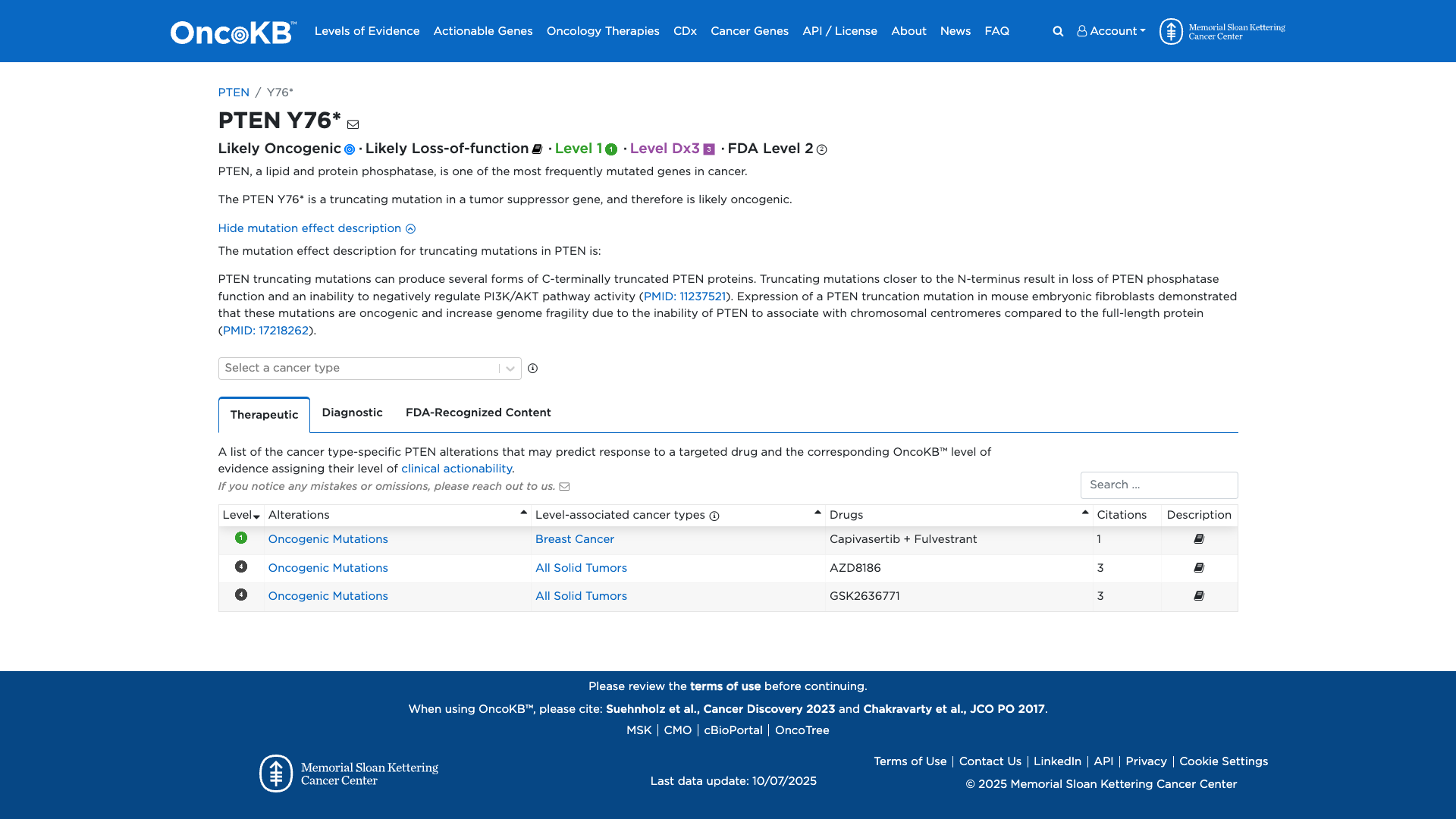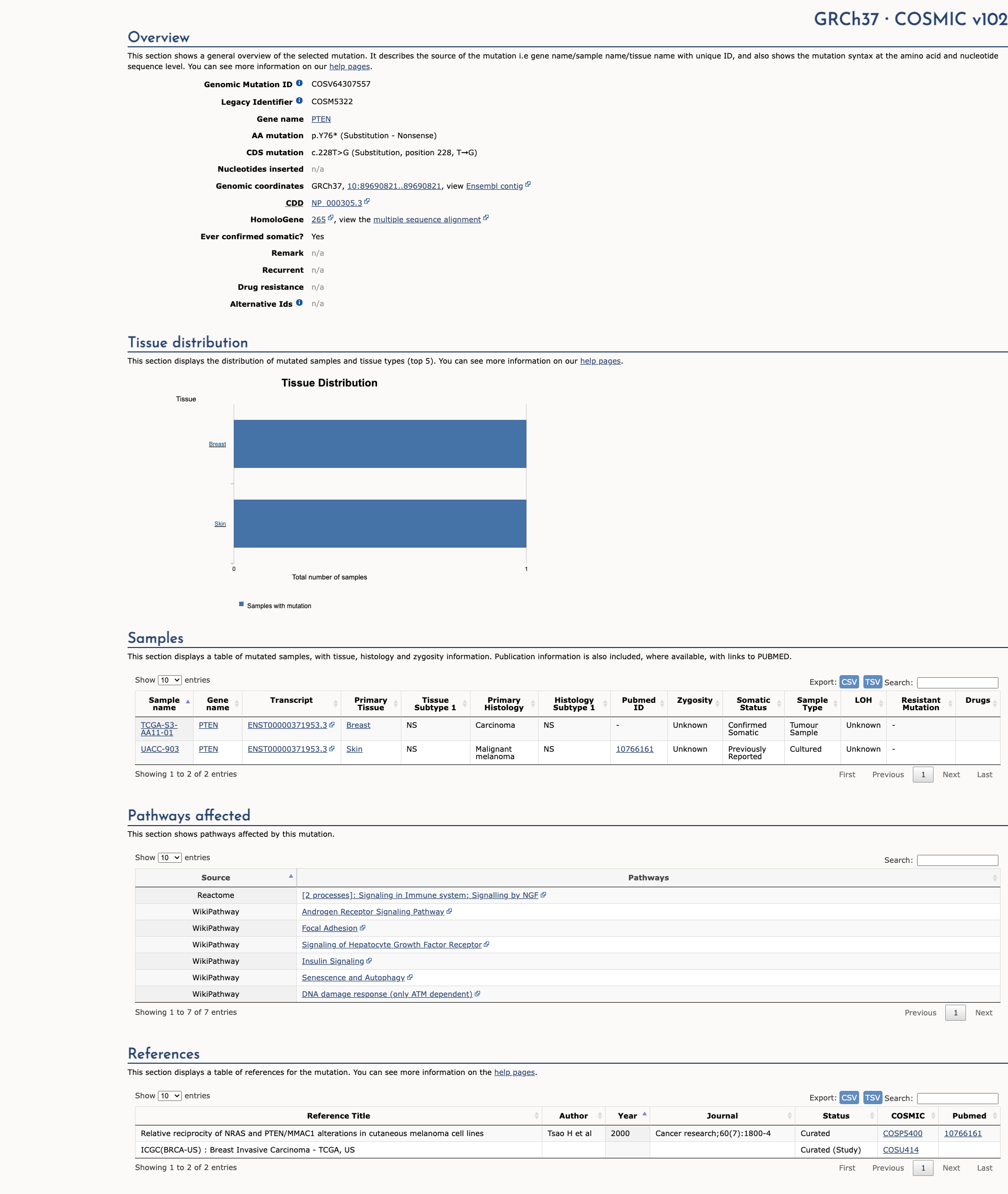PTEN c.228T>G, p.Tyr76Ter
NM_000314.8:c.228T>G
COSMIC ID: COSM5322
Pathogenic
NM_000314.8:c.228T>G (Y76*) in PTEN is an early truncating variant absent from controls, with functional data demonstrating loss of phosphatase activity, and reported as pathogenic by reputable sources. It meets PVS1_Very Strong, PS3_Moderate, PM2_Supporting, PP5_Supporting, and BP4_Supporting, supporting a Pathogenic classification.
ACMG/AMP Criteria Applied
PVS1
PS3
PM2
PP5
BP4
Genetic Information
Gene & Transcript Details
Gene
PTEN
Transcript
NM_000314.8
MANE Select
Total Exons
9
Strand
Forward (+)
Reference Sequence
NC_000010.10
Alternative Transcripts
| ID | Status | Details |
|---|---|---|
| NM_000314.7 | RefSeq Select | 9 exons | Forward |
| NM_000314.5 | Alternative | 9 exons | Forward |
| NM_000314.4 | Alternative | 9 exons | Forward |
| NM_000314.3 | Alternative | 9 exons | Forward |
| NM_000314.6 | Alternative | 9 exons | Forward |
Variant Details
HGVS Notation
NM_000314.8:c.228T>G
Protein Change
Y76*
Location
Exon 4
(Exon 4 of 9)
5'Exon Structure (9 total)3'
Functional Consequence
Loss of Function
Related Variants
Alternate Identifiers
COSM5322
Variant interpretation based on transcript NM_000314.8
Genome Browser
Loading genome browser...
HGVS InputNM_000314:c.228T>G
Active Tracks
ConservationRefSeqClinVargnomAD
Navigation tips: Use mouse to drag and zoom. Click on features for details.
Clinical Data
Population Frequency
Global Frequency
0.0 in 100,000
Extremely Rare
Global: 0.0%
0%
0.05%
0.1%
1%
5%
10%+
ACMG Criteria Applied
PM2
This variant is not present in gnomAD (PM2 criteria applies).
Classification
Pathogenic
Based on 2 submitter reviews in ClinVar
Submitter Breakdown
2 Path
Pathogenic
Likely Path.
VUS
Likely Benign
Benign
Publications (0)
No publication details.
Clinical Statement
This variant has been reported in ClinVar as Pathogenic (2 clinical laboratories).
Functional Impact
Functional Domain
Hotspot Status
Not a hotspot
Domain Summary
This variant is not located in a mutational hotspot or critical domain (0 mutations).
Related Variants in This Domain
Functional Summary
The PTEN Y76* variant is a truncating mutation that results in a premature stop codon, leading to the production of a truncated PTEN protein. Functional studies indicate that this variant results in reduced phosphatase activity, as demonstrated in a yeast assay, and is associated with a loss of PTEN protein function. This loss of function impairs the protein's ability to negatively regulate the PI3K/AKT pathway, contributing to oncogenic processes and increased genomic instability.
Database Previews
OncoKB

JAX-CKB

Click on previews to view full database entries. External databases may require institutional access.
Computational Analysis
Pathogenicity Predictions
Predictor Consensus
Mixed/VUS
PP3 Applied
No
Additional Predictors
Benign:
CADD: 9.39
Neutral: Show all
VCEP Guidelines
Applied ACMG/AMP Criteria (VCEP Specific) VCEP Guidelines
PVS1
PVS1 (Very Strong)
According to VCEP guidelines, the rule for PVS1 (Very Strong) is: "Null Variant (nonsense, fs, start codon, splicing +1/2, startgain, single or multi-exon deletion) in a gene where LOF is a known mechanism of disease". The evidence for this variant shows it is a nonsense change (Y76*) in PTEN, a gene where loss of function is a known disease mechanism and the variant is not in the last exon. Therefore, PVS1 is applied at Very Strong strength because it meets the disease-specific decision tree for a null variant in PTEN.
PS1
PS1 (Not Applied) Strength Modified
According to VCEP guidelines, the rule for PS1 is: "Same amino acid change as a previously established pathogenic variant regardless of nucleotide change OR different variant at same nucleotide position as a pathogenic splicing variant...". The evidence for this variant shows Y76* is a novel stop codon with no previously established pathogenic variant causing the same amino acid change. Therefore, PS1 is not applied.
PS2
PS2 (Not Applied) Strength Modified
According to VCEP guidelines, the rule for PS2 (Very Strong/Strong) requires confirmed de novo occurrence in a patient with disease and no family history. There is no de novo data available for this variant. Therefore, PS2 is not applied.
PS3
PS3 (Moderate) Strength Modified
According to PTEN pre-processing, the rule for PS3 (Moderate) is: "Phosphatase activity ≤ -1.11 per Mighell et al. 2018, PMID: 29706350." The evidence for this variant shows a high-confidence functional score of -3.0814, which is below the -1.11 threshold, indicating reduced PTEN phosphatase activity. Therefore, PS3 is applied at Moderate strength based on the PTEN‐specific functional assay result.
PS4
PS4 (Not Applied) Strength Modified
According to VCEP guidelines, the rule for PS4 requires increased prevalence in affected individuals (specificity score ≥2). No case‐control or proband specificity data are available for this variant. Therefore, PS4 is not applied.
PM1
PM1 (Not Applied) Strength Modified
According to VCEP guidelines, the rule for PM1 (Moderate) is: "Located in a mutational hot spot or critical functional domain (residues 90–94, 123–130, 166–168)." The evidence for this variant shows position Y76, which is outside these defined critical regions. Therefore, PM1 is not applied.
PM2
PM2 (Supporting) Strength Modified
According to VCEP guidelines, the rule for PM2 (Supporting) is: "Absent in population databases or at <0.00001 allele frequency in gnomAD." The evidence for this variant shows MAF = 0% in gnomAD. Therefore, PM2 is applied at Supporting strength because it is absent from control databases.
PM3
PM3 (Not Applied) Strength Modified
According to VCEP guidelines, the rule for PM3 applies to recessive disorders with variants observed in trans. PTEN‐related disease is autosomal dominant and no in trans data are relevant. Therefore, PM3 is not applied.
PM4
PM4 (Not Applied) Strength Modified
According to VCEP guidelines, the rule for PM4 (Moderate) is: "Protein length changes due to in-frame indels or stop-loss variants in non-repeat regions." This variant is a stop‐gain, not an in‐frame indel or stop-loss, so PM4 is not applied.
PM5
PM5 (Not Applied) Strength Modified
According to VCEP guidelines, the rule for PM5 (Moderate) is: "Missense change at an amino acid residue where a different missense change has been seen as pathogenic." This variant is a nonsense change, not missense. Therefore, PM5 is not applied.
PM6
PM6 (Not Applied) Strength Modified
According to VCEP guidelines, the rule for PM6 requires assumed de novo occurrence without confirmation of parentage. No de novo or family data are available. Therefore, PM6 is not applied.
PP1
PP1 (Not Applied) Strength Modified
According to VCEP guidelines, the rule for PP1 (Supporting/Moderate/Strong) is: "Co-segregation with disease in multiple affected family members." No segregation data are provided. Therefore, PP1 is not applied.
PP2
PP2 (Not Applied) Strength Modified
According to standard ACMG guidelines, PP2 applies to missense variants in genes with low benign missense tolerance. This variant is a nonsense change, not missense. Therefore, PP2 is not applied.
PP3
PP3 (Not Applied) Strength Modified
According to VCEP guidelines, the rule for PP3 (Supporting) is: "Multiple lines of computational evidence support a deleterious effect (REVEL >0.7 or SpliceAI/VarSeak concordance)." The evidence shows a CADD score of 9.39 and SpliceAI max score of 0.02, indicating no predicted deleterious effect. Therefore, PP3 is not applied.
PP4
PP4 (Not Applied) Strength Modified
According to standard ACMG guidelines, PP4 requires a patient phenotype highly specific for a single genetic etiology. No phenotype or clinical presentation data are provided. Therefore, PP4 is not applied.
PP5
PP5 (Supporting)
According to standard ACMG guidelines, the rule for PP5 is: "Reputable source reports variant as pathogenic without available evidence." The evidence shows two clinical laboratories in ClinVar report this variant as Pathogenic. Therefore, PP5 is applied at Supporting strength.
BA1
BA1 (Not Applied) Strength Modified
According to VCEP guidelines, the rule for BA1 (Stand Alone) is: "gnomAD filtering allele frequency >0.00056." The evidence shows allele frequency 0%, below threshold. Therefore, BA1 is not applied.
BS1
BS1 (Not Applied) Strength Modified
According to VCEP guidelines, the rule for BS1 (Strong) is: "gnomAD filtering allele frequency between 0.000043 and 0.00056." The evidence shows allele frequency 0%, below this range. Therefore, BS1 is not applied.
BS2
BS2 (Not Applied) Strength Modified
According to VCEP guidelines, the rule for BS2 (Strong/Supporting) is: "Observed in homozygous state in healthy individuals." No homozygous observations are reported. Therefore, BS2 is not applied.
BS3
BS3 (Not Applied) Strength Modified
According to VCEP guidelines, the rule for BS3 (Strong) is: "Well-established functional studies show no damaging effect." Functional studies for this variant demonstrate loss of function, not normal function. Therefore, BS3 is not applied.
BS4
BS4 (Not Applied) Strength Modified
According to VCEP guidelines, the rule for BS4 (Strong) is: "Lack of segregation in affected members of two or more families." No segregation data are available. Therefore, BS4 is not applied.
BP1
BP1 (Not Applied) Strength Modified
According to standard ACMG guidelines, BP1 applies to missense variants in genes where only truncating variants cause disease. This variant is truncating, so BP1 is not applicable. Therefore, BP1 is not applied.
BP2
BP2 (Not Applied) Strength Modified
According to VCEP guidelines, the rule for BP2 (Supporting) is: "Observed in trans with a pathogenic PTEN variant or in cis >3 times." No such observations are reported. Therefore, BP2 is not applied.
BP3
BP3 (Not Applied) Strength Modified
According to standard ACMG guidelines, BP3 applies to in‐frame indels in repetitive regions. This variant is a nonsense change. Therefore, BP3 is not applied.
BP4
BP4 (Supporting)
According to VCEP guidelines, the rule for BP4 (Supporting) is: "Multiple lines of computational evidence suggest no impact." The evidence shows CADD 9.39 (< pathogenic threshold) and SpliceAI 0.02 (no splicing impact). Therefore, BP4 is applied at Supporting strength.
BP5
BP5 (Not Applied) Strength Modified
According to VCEP guidelines, the rule for BP5 (Supporting) is: "Variant found in a case with an alternate molecular basis for disease." No alternate genetic diagnosis is reported. Therefore, BP5 is not applied.
BP6
BP6 (Not Applied) Strength Modified
According to standard ACMG guidelines, BP6 is: "Reputable source reports variant as benign without evidence." No reputable benign reports exist. Therefore, BP6 is not applied.
BP7
BP7 (Not Applied) Strength Modified
According to VCEP guidelines, BP7 applies to synonymous or intronic variants with no predicted splicing impact. This variant is nonsense, not synonymous/intronic. Therefore, BP7 is not applied.

